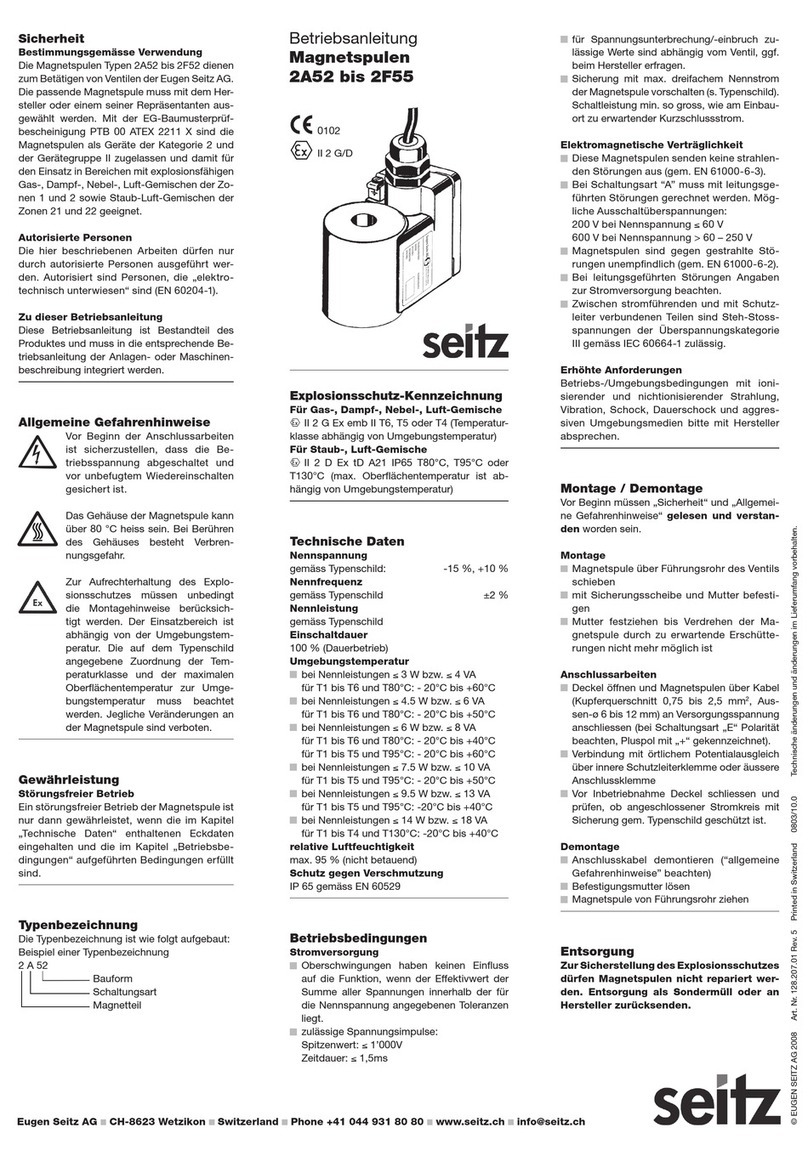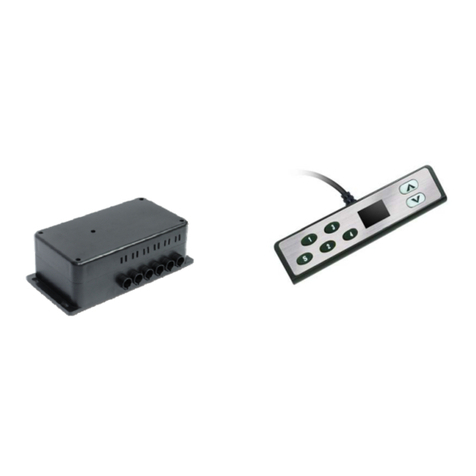
© EUGEN SEITZ AG 2014 Art. Nr. 128.204.01 Rev. 06 Printed in Switzerland 1404/2.0 Sous réservé de modifications techniques et de modifications de la définition des fournitures.
Eugen
Seitz
AG
CH-8623
W
etzikon
Switzerland
Phone
+41
044
931
80
80
www.seitz.ch
[email protected]Caractéristiques techniques
Tension nominale
Voir plaque signalétique -15 %, +10 %
Fréquence nominale
Voir plaque signalétique ± 2 %
Puissance nominale
Voir plaque signalétique
Durée d’enclenchement
100 % (fonctionnement continu)
Température ambiante
pour T1 à T6 et T80°C: -50°C à +40°C
pour T1 à T5 et T95°C: -50°C à +55°C
pour T1 à T4 et T130°C: -50°C à +90°C
Humidité relative
max. 95 % (pas en dégel)
Protection contre l’encrassement
IP 65/67 conformément à EN 60529
Conditions de service
Alimentation électrique
Les vibrations harmoniques n‘ont aucune in-
fluence sur le fonctionnement lorsque la valeur
effective de la somme de toutes les tensions
sont dans la plage de tolérance indiquée pour la
tension nominale.
Impulsions de tension admissibles:
Valeur de pointe: ≤1000 V
Durée temporaire: ≤1,5 ms
Les valeurs admissibles pour les coupures/
chutes de tension dépendant de la vanne utilisée
(veuillez vous renseigner le cas échéant auprès
du fabricant).
Installer en amont de la bobine magnétique un
fusible de sécurité avec au maximum le triple de
l‘intensité nominale de cette dernière (voir plaque
signalétique). Puissance de rupture au moins
aussi grande que le courant de court-circuit at-
tendu au lieu de montage.
Compatibilité électromagnétique
Ces bobines magnétiques n‘émettent aucun
rayonnement parasite (conformément à EN
61000-6-3).
Pour le type de circuit «A», ont doit s‘attendre
à des perturbations le long du câblage. Surten-
sions de déclenchement possibles:
200 V à une tension nominale ≤60 V
600 V à une tension nominale > 60-250 V
1000V à une tension nominale > 250-400 V
Les bobines magnétiques sont insensibles aux
perturbations de rayonnement (conformément à
EN 61000-6-2).
Pour des pertubations conduites par des
conduits, observez les données concernant
l’alimentation.
Des tensions de tenue aux ondes de choc de
la catégorie de surtensions III conformément à
IEC 60664-1 sont admissibles entre les pièces
conductrices et les pièces reliées au conducteur
de protection.
Exigences techniques plus rigoureuses
Pour l‘emploi des bobines magnétiques dans des
conditions de service et environnantes avec rayon-
nement ionisant et non ionisant, vibrations, chocs,
chocs continus et médias environnants agressifs,
veuillez consulter le fabricant.
Montage / Démontage
Avant le début des travaux de montage/ démon-
tage, veiller à ce que les chapitres «Sécurité» et
«Consignes de sécurité générales» aient été lues
et bien comprises.
Montage
Faire glisser la bobine magnétique sur le tub
conducteur de la vanne.
La fixer avec une rondelle de sécurité et un
écrou.
Serrer l‘écrou jusqu‘à ce que les vibrations pré-
vues ne puissent plus faire tourner la bobine
magnétique (couples de serrage 15 à 20 Nm).
Travaux de raccordement
Raccorder la bobine magnétique à l‘aide de pas-
sages de câbles ou de conduites ou à des systèmes
de conduites rigides conformes aux exigences de
la norme EN 60079-1 et pour lesquelles leur propre
certificat de contrôle a été délivré. Ne pas utiliser
de passages de câbles ou de conduites sans
certificat de contrôle Ex-d/Ex-t!
Ouvrir le couvercle (clé à fourche 17mm)
Raccorder les bobines magnétiques avec des
câbles (section de cuivre 0,75 à 1,5 mm
2
) à la
tension d‘alimentation. Pour le type de circuit
«E», tenir compte de la polarité (pôle positif re-
péré par «+»).
Pour les températures ambiantes ≥50°C, tenir
compte de l‘échauffement de 20 K au point d‘in-
troduction du câble.
Raccordement avec liaison équipotentielle locale
par la borne de conducteur de protection interne
ou la borne de raccordement externe.
Avant la mise en service, fermer le couvercle à
l‘aide de la clé à fourche en serrant cette dernière
jusqu‘à la butée.
Tourner le couvercle dans le sens inverse jusqu‘à
ce que la vis sans tête puisse être positionnée
sur le trou d‘arrêt le plus proche.
Serrer solidement la vis sans tête à l‘aide de la
clé à fourche (2 mm).
Démontage
Démonter les câbles de raccordement (en obser-
vant les «Consignes de sécurité générales).
Desserrer l‘écrou de fixation.
Retirer la bobine magnétique du tube conduc-
teur.
Elimination des déchets
Afin de garantir la protection contre l‘explo-
sion, il est interdit de réparer les bobines ma-
gnétiques. Elimination comme déchet spécial
ou les renvoyer au fabricant.
Sécurité
Utilisation conforme
Les bobines magnétiques des types 2A6x, 2C6x,
2E6x et 2F6x servent à la commande de vannes
fabriquées par la société Eugen Seitz AG. La bo-
bine magnétique correspondant à vos besoins doit
être choisie avec le fabricant ou son représentant.
Les bobines magnétiques sont classifiées, confor-
mément à l‘attestation de contrôle d‘homologa-
tion BVS 14 ATEX E011 de la Communauté Euro-
péenne, comme appareils de la catégorie 2 et du
groupe d‘appareils II, ce qui permet leur utilisation
dans les zones 1 et 2 comportant des gaz, vapeurs,
brouillards et mélanges d‘air explosifs ainsi que des
mélanges poussière, air des zones 21 et 22.
Personnes autorisées
Veiller à ce que les travaux décrits ici soient effectués
uniquement par des personnes autorisées. Seront
considérées comme autorisées les personnes «ini-
tiées en matière électrotechnique» (EN 60204-1).
Information sur le présent mode d‘emploi
Le présent mode d‘emploi est partie intégrante du
produit et doit être intégré dans les instructions de
service ou la description mécanique correspon-
dantes de l‘installation.
Consignes de sécurité générales
Toute modification est inerdite afin de garantir la
protection antidéflagrante de la bobine magnétique.
Avant de commencer tous travaux de
raccordement et du démontage, s‘assu-
rer que la tension de service est coupée
et que la machine est protégée contre
toute remise sous tension intempestive.
Le carter de la bobine magnétique peut
s‘échauffer à plus 80°C.
Danger de brûlure!
En vue de préserver la protection contre
l‘explosion, observer absolument les
instructions de montage. Le domaine
d‘application dépend de la température
ambiante. Prière de tenir compte de l‘af-
fectation de classe de température par
rapport à la température ambiante indi-
quée sur la plaque signalétique.
Garantie
Le fonctionnement sans dérangement de la bobine
magnétique n‘est garanti que si tous les paramètres
indiqués au chapitre «Caractéristiques techniques»
ont été observés, et toutes les conditions énoncées
au chapitre «Conditions de service» sont remplies.
Code de désignation
Exemple de code de désignation:
2 A 65
Forme de construction (en
fonction du filetage
d‘introduction de câble)
65 = NPT 1/2
67 = M 20x1,5
Type de circuit
Partie magnétique
Identification de la protection
contre l‘explosion
II 2 G Ex db IIC T6, T5 ou T4
II 2 D Ex tb IIIC T80°C, T95°C ou T130°C
Les bobines magnétiques sont conformes aux
normes suivantes:
EN 60079-0:2012, EN 60079-
1:2007 et EN 60079-31:2009
Mode d’emploi
bobines magnétiques
2A6x, 2C6x, 2E6x, 2F6x
II 2 G/D
1258
DE/GB/ES/FR /IT/RU
























